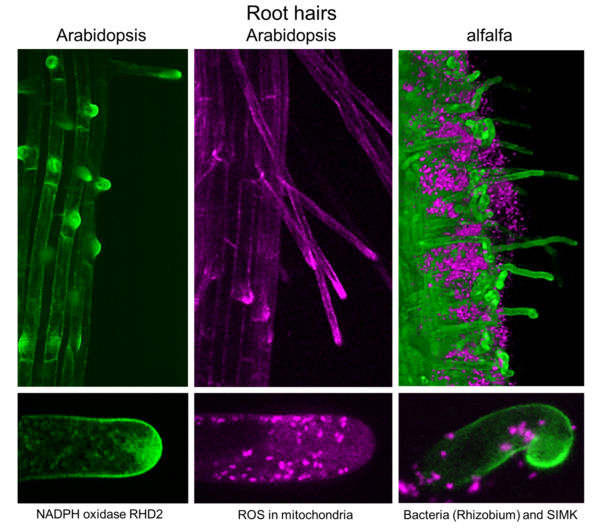Scientists from the Palacký University Faculty of Science (UP FS) have described an important part of the complex mechanism by which plants control the growth of root hairs. These small and numerous endings of the root system play an important role in the life of plants in drawing water and nutrients from the soil. Together with the new method of gentle microscopic examination of root hairs, successfully tested by scientists from Olomouc led by UP FS Department of Biotechnology scientists Miroslav Ovečka and Jozef Šamaj, this knowledge might be used in the cultivation of agricultural crops.
The results of their research on root hairs were published in three separate publications in the prestigious journals Plant Physiology and Journal of Experimental Botany. All three scientific articles were featured on the covers of these journals.
Plants are anchored in the soil by roots, which are indispensable for their growth, development, and prosperity. The quality of the root system depends on root hairs representing tubular outgrowths of individual cells of the root epidermis, called trichoblasts. Root hairs are an important model in the developmental and cellular biology of plants, on which scientists intensively study the polarity of plant cells and the regulatory mechanisms.
A number of factors are responsible for the polar growth of root hairs, which occurs only at their apex. “But we still don’t know many of these factors. We know that proteins anchored in the plasma membrane play an important role. The question remains, however, how root hairs achieve and maintain their asymmetric accumulation in the growing tip,” said Ovečka, who, together with Jozef Šamaj, heads a group of scientists investigating what happens inside root hairs.
A recently published study from their laboratory focused on the issue of root hair growth. Experts have found that the apical part of the root hair, including the plasma membrane, constantly moves laterally away from the apex due to growth. According to Ovečka, it was therefore important to clarify how the optimal concentration and precise localization of membrane proteins in the growing tip is maintained in order to understand the mechanism of spatial and temporal regulation of root hair tip growth. “This also applies to the mechanism of polarized transport and the incorporation of these proteins into the plasma membrane,” noted Ovečka.
The scientists, using the model species Arabidopsis thaliana, demonstrated that in the case of an enzyme producing reactive oxygen species in the cell wall, its optimal concentration in the tip of the root hair is created through dynamic vesicular transport using the trans-Golgi vesicle network. Experts discovered this mechanism thanks to the use of advanced qualitative and quantitative “light-sheet” and super-resolution microscopy.
In the second published study, the scientists not only demonstrated the fundamental role of reactive oxygen species in the regulatory mechanism of root hair growth, but also presented to the plant community effective and easily applicable procedures for their labelling and detailed microscopic localization. “Reactive oxygen species are small molecules that, as their name implies, are highly reactive. In the cell, they are used positively as signalling molecules in various developmental processes, however, under stress situations, their excessive production leads to damage to cellular structures,” said Ovečka.
The plant cell must therefore keep reactive oxygen species under control. However, due to their physical and chemical properties, the possibility of detailed visualization of reactive oxygen species in living growing cells has been difficult to achieve until now. “In Arabidopsis thaliana, we succeeded in developing methods for the precise subcellular localization of diverse reactive oxygen species with resolution at the level of individual cell organelles in root hairs, simultaneously maintaining optimal physiological conditions for their undisturbed growth. This new, attractive method enables high resolution while preserving all the dynamic processes needed for root hair growth,” Ovečka pointed out .
According to Šamaj, the new findings of Olomouc scientists opened the way to a detailed study of living root hairs at the highest possible spatial and temporal resolution using the most modern microscopic methods. “We used it when studying the Arabidopsis model plant, but our ambition was to transfer and successfully apply the acquired know-how to agricultural crops,” Jozef Šamaj pointed out.
Scientists have long focused their attention on alfalfa and barley. Especially in alfalfa, root hairs play an irreplaceable role in establishing a symbiotic relationship between this plant and beneficial soil bacteria of the genus Rhizobium, which leads to the assimilation of atmospheric nitrogen in the root nodules. “Our study demonstrated that the mitogen-activated protein kinase SIMK is significantly involved in this process. This kinase plays an important signalling role, especially in the early recognition of beneficial bacteria and their internalization into root hairs,” added Ovečka.
The results of the researchers considerably supplemented the currently valid model of the initiation of symbiotic interaction between legumes and Rhizobium soil bacteria. “Understanding this process can undoubtedly have enormous agricultural and biotechnological application potential,” added Šamaj.
The research was supported by the Grant Agency of the Czech Republic grant GA19-18675S, “Elucidation of the roles of actin, NADPH oxidase and structural sterols in the apical growth of root hairs using advanced microscopy and proteomics”, conducted in the period 2019–2023.
